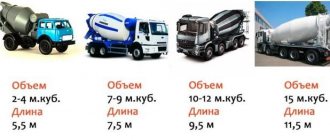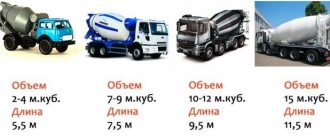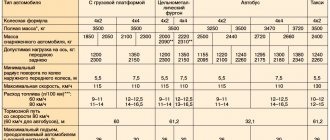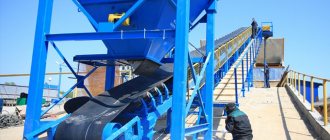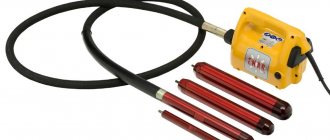Almost all construction work is carried out using different mixtures. For the production of feed, concrete, mortar and other consistencies from hard and loose parts, very effective industrial devices are used - concrete mixers. They significantly simplify and speed up the execution of specific tasks.
Next, we will answer the most pressing questions that concern most builders:
How many cubes are there in a concrete mixer? How much solution is needed? How to choose a concrete mixer? How to avoid fraud when shipping from a mixer? How much does the mixer weigh?
Types of concrete mixers
The main function of the concrete mixer is to increase the productivity of mixing elements. A hydraulic or gasoline engine powers the tank and gutters. Units of this group can be of various types: from mini-devices, for small individual households, up to large portable units needed in enterprises.
Concrete mixers are a working tank with special blades located on the inside. These blades are provided for the purpose of stirring to the desired consistency and reducing the overload on the block.
The volume of a concrete mixer in cubes can be from 100 to 300 liters. and more, depending on the power of the equipment and the scale of the work performed.
By mechanism:
- Gravitational.
Concrete - the solution is mixed due to gravity - the force of gravity. One of its main components is an iron or plastic tank (pear), with blades attached to the inside walls. The positions of this unit are adjustable. It rotates along the longitudinal axis, and the mixture is stirred by the blades. Electric motors with low power are used for drive. It can be used to produce heavy consistencies, including crushed stone. The system can be transported by trailer on a car. And, if necessary, it is easy to disassemble and reassemble.
- Geared.
They are distinguished by a high level of protection of the gearbox from sand, water, and debris. For this reason, such installations are reliable and durable. However, if the gearbox fails, it is very difficult, almost impossible, to repair the device.
- Crowns.
Thanks to the gear wheel (rim), the drum rotates. It is located outside the machine and its elements are in no way protected from debris, dirt, dust, and hard elements. For this reason, the crown wears out quite quickly and fails. The wheel material can be polymer, alloy or cast iron. The most reliable and durable are cast iron types. Changing or restoring it does not present such difficulties as in the case of gearboxes.
Mobile - used by developers on large construction sites. They remain stationary on objects, and upon completion of work they move to other areas. This concrete mixer can hold up to 0.12 cubic meters.
An automixer - a drum - is an essential component of the machine and is equipped with a special transport belt for uniform distribution of the solution or filling of small areas. Machine size, approximately: width - from 2.5 to 2.5 m, length - from 7 to 9.6 m, height - 3.5 to 4.5 m. The designs of self-loading concrete mixers differ in the presence of a unit in which substances are placed to form a solution. Very expensive equipment that requires a close location of the material base for constant operation. The capacity of the concrete mixer machine is from 4 to 11 tons. There are mini modifications with a capacity of 2.5 tons.
Depending on the operating mode:
- Continuous action.
The functioning of such devices is carried out continuously; loading of starting substances and the finished consistency can be carried out without stopping the device. The quality of the unloaded substance is controlled through the use of special equipment. Constructions of this type are indispensable when it is necessary to produce large quantities of concrete solutions. A characteristic feature of the work of this variation is considered to be cyclical. They are used when the concrete mixture is poured gradually. Used in the construction of large objects. To calculate the work, you need to know: how much concrete is produced in a concrete mixer of this type per hour → 120-130 m3.
- Cyclical.
They have a more elementary system and a tank with a smaller capacity, and the control is easy to automate. They provide the possibility of distribution into specific cycles - unloading, loading, mixing.
- Forced.
The main characteristic of such mixers is a paddle mixer with 2 shafts. The mixing procedure is performed by machine elements. They are supplied with a fixed container and shafts located in a vertical or horizontal position. The mixer provides high quality by combining properties, forced and gravitational apparatus. This type of mechanism is distinguished by a short period of mixing the mortar or concrete, and a high-quality composition is obtained when using different dry parts. The downside is the high energy costs, and in addition, the complexity of the system, which will require proper high-quality maintenance. Such installations are expensive, but the most productive. The answer to the question of how many cubes does a concrete mixer of this modification produce per hour? → up to 60 m3.
Household - low-power, used for individual construction. The mixer does not exceed 50 liters and is light in weight. The weight of such a mixer with concrete does not exceed 150 kg.
Delivery
Concrete mixers are a convenient way to prepare cement mortar. For some chassis-mounted varieties, there is another application: with their help, industrial companies deliver the solution to customers, maintaining it in a liquid state. The width of the Kamaz concrete mixer allows you to deliver a significant amount of mortar in one trip.
Of course, you can make the solution yourself, but you need to spend some time on it and you cannot guarantee the high quality of the concrete obtained in this way.
Concrete is made this way without a concrete mixer Source yandex.net
It is convenient to use the services of specialized companies that will not only prepare the cement mixture of the required brand, but also deliver the liquid mixture, ready for use, directly to the construction site.
Receiving such services has its positive aspects:
- The supply of solution for preparing concrete occurs quickly and efficiently. This is beneficial both for the construction of private houses and for large construction projects.
- With the help of mixers, delivery can occur over long distances without loss of quality.
- When providing services, it is usually provided not only for the unloading of manufactured products, but also for the direct pouring of cement mortar.
This sales method allows the client to order exactly the volume of solution that he needs.
How to make the right choice of concrete mixer
Before deciding on the choice of unit, you need to calculate the required amount of required material using the following formulas:
- strip length (m) × strip section (m2) = amount of concrete needed for strip foundation (m3).
- strip length 1 (m) × section 1 (m2) + length 2 (m) × section 2 (m2) + strip length 3 (m) × section 3 (m2) = amount of concrete for strip foundations with different sections (m3).
- slab length (m) × slab width (m) × slab height (m) = amount of concrete for slab foundation (m3).
- room area (m2) × screed thickness (m) = calculation of concrete for pouring the floor screed (m3).
Drum Capacity Determination
Of course, to build a not very large car - a garage and a bulky country house with a swimming pool - you need different amounts of concrete, which means you will need different concrete mixers. The volume of concrete in a concrete mixer for various works should be (cubes):
- For small pets - 0.18, 0.125, 0.165.
- For large-scale construction, it is more correct to choose up to 0.3.
To build a private building, you need to know exactly how many cubes of concrete there should be in a concrete mixer for effective work. This figure is approximately → 90-150l.
For high-quality mixing and avoiding overloads, the size of the finished mixture should be 2/3 of the tank. The mixing procedure according to the more common gravitational scheme involves an oblique position of the drum, and it is impossible to fill it to the brim. The volume of concrete should not be higher than 2/3 of the total capacity - for example, for a concrete mixer with a 120 liter drum. it will be approximately → 80 l.:
- How much concrete in a concrete mixer is needed to build a garage - up to 22 kilograms, capacity - up to 100 liters.
- One-story buildings, bathhouse: capacity of the concrete mixer - 100-150 liters, weight - from 40 kilograms.
- Buildings with 2 and 3 floors: size - 150-300 liters, weight - from 48 kilograms.
To calculate how many cubes are in a concrete mixer, and what volume the tank should be, the amount of mixture must be taken with a reserve of approximately 10-15%.
Engine power determination
A parameter such as motor power affects the ability of the unit to knead large or heavy fractions at the proper level. The main thing is to understand the correct match between the capacity and power of the motor used. All “home” representatives operating from a 220V network are equipped with motors - up to 1 kW. More powerful units operate at 380V. For constant kneading, 12 hours, 150-800 W is enough. For production around the clock - more than 1000 W. For individual construction, a device with a power of 700V, with a tank size of 120 liters, is sufficient.
A common mistake is that an inexperienced consumer purchases modifications with the maximum permissible value. As a result, construction costs significantly more due to high energy costs.
Final installation choice
Electric drive – power is supplied from 220 V; such mixers are easy to operate and can be used in confined spaces.
ICE (diesel fuel) - from an internal combustion engine. These installations are independent and do not require external power, which makes it possible to use them, including in complete isolation from civilization. Fuel is more expensive than electricity, and the resulting exhaust gases make it possible to use them only in open areas.
Domestic concrete mixers stand out for their quality. Although they are clumsily manufactured, the key components used for assembly are of good quality. The warranty must be at least two years.
Rating
If you plan to purchase a mixer for working at home, it makes sense to pay attention to the following rating of concrete mixers, which includes popular and high-quality models:
- RedVerg RD-CM 63
It has a drum volume of 63 liters. It is suitable for building a summer house. This concrete mixer can be purchased at an affordable price. She has a high-quality polymer crown. Disadvantages are loud noise,
- Concrete mixer Lebedyan RN-200
Suitable not only for home use, but also for professional construction work. The drum volume is 200 liters. Immediately after the end of the cement mortar preparation cycle, you can start the next one. A powerful electric motor is used. A batch of solution can be prepared in two minutes.
Concrete mixer Lebedyan Source i1.ytimg.com
- Model SBR-100
Has a cast iron crown. The solution preparation time is one and a half minutes. This concrete mixer operates from a 220 V network. Rotation is transmitted from the motor using a soft belt. If operated in a state of overload, it may wobble greatly.
There are various types of concrete mixers on sale, among which the client can always choose the most suitable one.
Selection of equipment regarding design features and required volume
Characteristic features of designs that are important to consider when choosing a model:
- The most durable transmission method is considered to be a gearbox, but more well-known modifications have a ring gear, which is easier to repair.
- In addition, the engine must be protected from water, since the system is located in the open air.
- The presence of wheels will make transportation easier.
- The functionality of loading ingredients and unloading the finished mixture is also important. You can do this manually yourself or with the support of a special bucket.
In addition, the installation can be equipped with dispensers. And, the material of the drum body is steel no thinner than 1 mm, since concrete corrodes the alloy.
ABS technical specifications
The safety of the concrete mixture during transportation is ensured by the constant rotation of the drum, inside of which there is a mechanism with mixing blades. The mixer is unloaded by the reverse movement of the blades. When ordering a concrete mixer truck, you must consider the following characteristics:
- Drum volume. Manufacturers of construction equipment produce drums of various sizes: from mini-mixers of 2 m 3 to large ones of 15 m 3. Mixers of impressive volume are used in the construction of large-scale projects, for example, when pouring a foundation;
- Mixer filling capacity. Given the stated technical characteristics, it is worth considering that ABS is almost never filled to capacity. This is due to the tightening of fines for overloading since 2015. As a rule, the actual filling of the drum is 1-3% lower than the maximum;
- Sleeve or gutter length. The device through which concrete is unloaded from the mixer has a length of 1.5-2 m. Suppliers often offer elongated hoses, and the unloading time increases accordingly;
- Weight of loaded concrete mixer truck. This parameter is important when delivering within the city, where there are weight restrictions for special vehicles, as well as when driving the vehicle on viscous soil. In many cases, it is more economical to order two or three 6-cc mixers instead of one per 12-15 m 3.
Volume of concrete in the mixer
How many cubes of concrete can the mixer hold?
To establish this quantity, you need to understand that special equipment is equipped with tanks from 2 to 16 m³:
- modifications 5.5 m long – 2-4 (m3);
- 7.5 m – 7-9 (m3);
- 9.5 m – 10-12 (m3);
- 11.5 m – 15 (m3).
Sizes from 6 to 8 m3 are considered more common and widely used. The capacity of the system is affected by the manufacturer and modification (from 2 to 16 m3). You need to realize that it is impossible to use the tank completely; it will not tolerate this kind of rhythm and will quickly fail. In addition, it is important to know how much a concrete mixer with concrete weighs, since not every building surface or platform will be able to withstand such weight, because it is so filled with special equipment. equipment can weigh up to 25 tons. Typically, the weight of a mixer with concrete is 14–15 tons.
What are the advantages of ordering a mixer with concrete?
How many cubes are there in a concrete mixer?
They hold from 4 to 11 m3 of mixture.
Such installations make it possible to obtain a homogeneous mass from the necessary ingredients in a short period of time. Thanks to the continuous rotation of the concrete mixer, the solution does not set. However, this does not mean that the composition can be left overnight or stirred for days. The mixer is suitable for forming concrete of any brand, and the operating link will crush and mix crushed stone of any hardness.
Types of mixers and their parameters
A mixer is a truck with a constantly rotating tank for transporting concrete. They are stationary and mobile. Such a special equipment is divided into mechanical and hydraulic.
Feeding is done through a chute (from 1.5 to 2 meters). In addition, unloading can be carried out in different ways:
- “back” (more common) - requires the participation of another person to control the gutter;
- “forward” - the driver is able to control the unloading progress alone from the truck cab.
It is possible to make an elongated gutter - sleeve, by workers (up to 5 m). The technological special equipment of Russian concrete mixer trucks has few differences and is unified to the maximum.
Concrete mixer volume (in cubes):
- Kamaz - from 4 to 8.
- Ural, MAZ, Mercedes, Renault, Man, Mitsubishi, Volvo - up to 12.
Concrete mixer trucks are ready to work at temperatures from - 30 to + 40 C0. The maximum speed of loaded vehicles when moving along tracks in a technological order is no more than 60 km/h. Mixing drums have a constant axle roll angle (10 - 15) to the horizon.
Calculation of the amount of solution
What volume should I order and how many cubes of concrete are in the mixer?
Calculating the quantity in a car mixer depends on its capabilities. I don’t want to disappoint the reader, but to answer the question: how many cubes of concrete are in a concrete mixer? No one will give a clear answer, but there are several options to approximately determine the volume and how much concrete was delivered. Much depends on the brand of concrete mixer truck. The size of the drum, its load-bearing capacity and the power of the engine are taken into account. The volume of a domestically produced concrete mixer is 5 cubic meters. Most of the devices are 4-6 m3 in size. Chinese - up to 4 m3.
Method 1.
It is possible to resort to the following option for establishing the amount of concrete, but for this you need to be at the plant when loading the solution. An empty, five-cube concrete mixer weighs 11 tons. 1 cubic meter of concrete = 2.4 tons. If this is a complete unit, its weight on industrial scales should be 23 tons.
If there are 2.4 tons of solution in one cube of concrete. How many concrete mixers are needed for an order of 15 tons? A simple calculation shows that if you order 3 concrete mixers of 7 tons each, you will get approximately 15 tons of mortar.
Estimated cost:
- 5 tons of train, with transportation 20 kilometers = approximately $150
- 5 tons of train, with transportation 50 kilometers = 220 $
- 10 tons of train, with transportation over a similar distance = $450-500
Method 2.
Establish roughly how much was delivered to you, perhaps using this method. With standard operation of absolutely all elements of the machine, 1 cubic meter of solution is unloaded in approximately 10 minutes. Consequently, a five cubic meter tank will be empty in 50 minutes.
And one more important note: It is not difficult to accurately calculate the quantity to order. The length of the object must be multiplied by the height and width, with a margin. If you need 5.4 m3, buy 5.5 m3. Therefore, it is also necessary to first consider where it is possible to profitably pour the remaining mixture.
What to pay attention to
Concrete must be selected and paid for personally. Be present during loading, transportation and filling and do not allow water to be added. When purchasing, you need to avoid suspicious services. Thoroughly control in paperwork: brand, weight, mobility, date of shipment, volume of concrete mixer m3. Judging by its appearance during the period of unloading concrete, it is impossible to determine the grade; this can only be done in the laboratory. In order to reduce the risk, and if a non-conformity is identified, to be able to file a claim, it is best to purchase concrete under a pre-concluded agreement and directly from a reputable manufacturer.
What you should pay attention to
Before ordering a building mixture and calculating how much Kamaz concrete takes, you need to carefully prepare everything. After all, ready-made concrete will not stand for long and will begin to harden fairly quickly, so it must be used sparingly and not be distracted by other tasks.
What you need to do when ordering the mixture:
- Provide access roads for concrete mixers - you may need several unloading points (for significant volumes of monolithic work).
- Clear the area for parking the mixer, from where the supply will be carried out - it is desirable that the distance is 8 meters from the edge of the trench. The slope should not be more than 5%, the dimensions of the site should be at least 6 by 8 meters.
- Prepare all the tools for work - a vibrating plate for compaction, and other devices.
- Think about where the excess mixture will be drained - you can assemble formwork for some small structures (barbecue, fence, etc.).
- Order delivery only from trusted manufacturers, having previously read the reviews - after all, it will be difficult to control the volume of the mixture; a lot depends on the honesty and integrity of the supplier.
- It is better to plan delivery in the morning so that you have time to use up all the solution.
- If you need several mixers, you need to first draw up a schedule for the arrival of Kamaz trucks and a work plan. It is advisable to leave a gap of at least 2 hours between flights.
- When receiving the mixture, be sure to check the delivery note, a certain sample quality certificate for the solution, which indicates the brand, volume, etc.
Delivery of concrete mortar using a KamAZ mixer is an excellent opportunity to save time, money and effort by obtaining a high-quality mixture that meets all requirements.
Sources
- https://kladembeton.ru/poleznoe/skolko-v-miksere-kubov-betona.html
- https://SpecNavigator.ru/avtobetononasos/vmestitelnost-betonosmesitelya-na-baze-kamaz.html
- https://RetroTruck.ru/stroitelnaya/skolko-betona-v-miksere-kamaz.html
- https://tractoramtz.ru/strojtehnika/skolko-kubov-v-betonomeshalke.html
- https://evacuatornahabino.ru/spetstehnika/skolko-kubov-betona-v-miksere-kamaz-obem-betonosmesitelya.html
- https://eurobeton61.ru/vse-o-betone/skolko-kubov-betona-v-miksere/
- https://salecement.ru/skolko-kubov-betona-mozhet-dostavit-mikser-kamaza-za-odnu-hodku/
